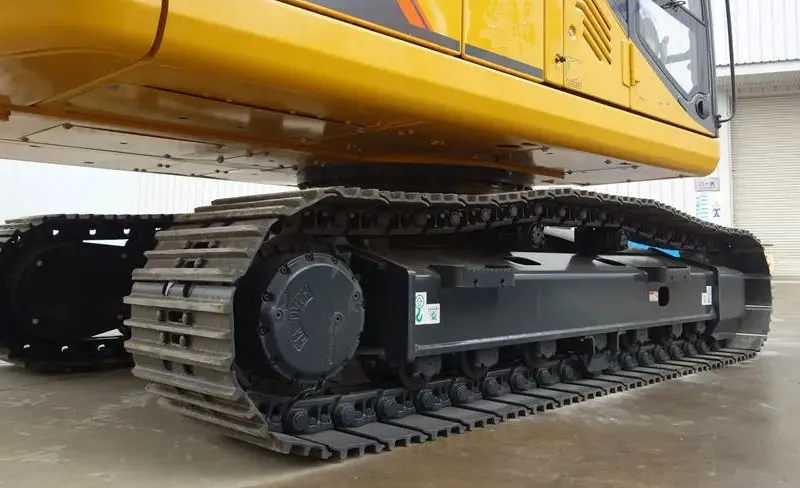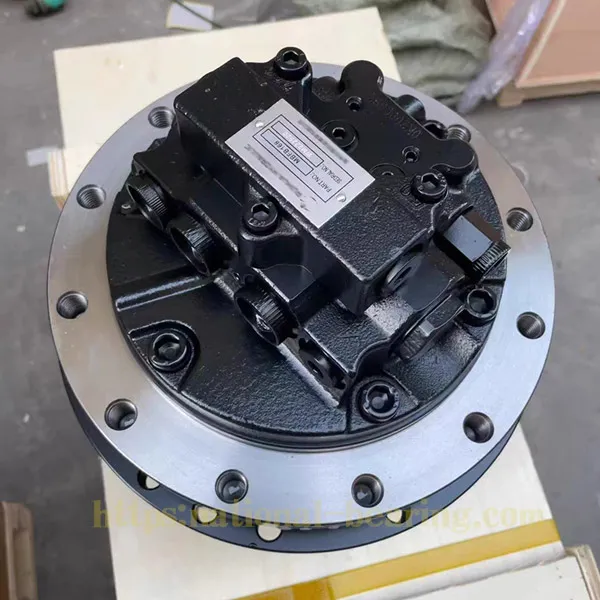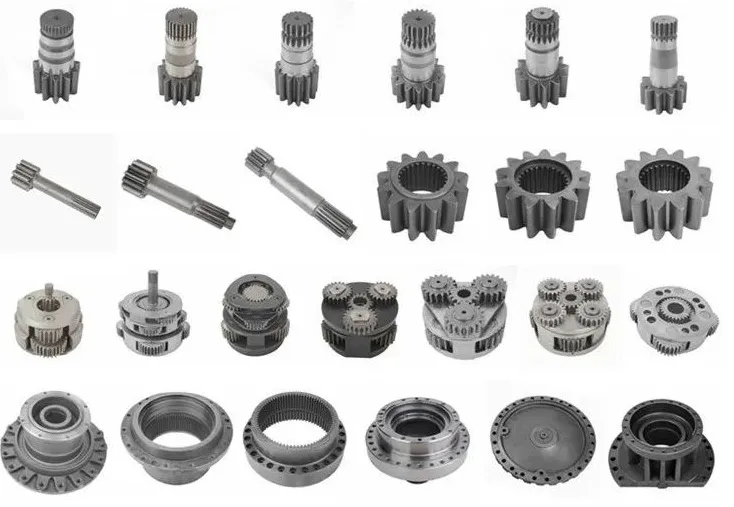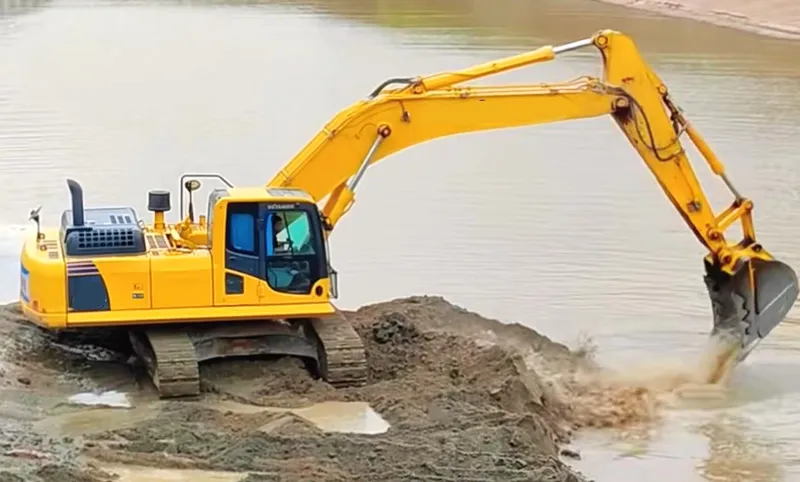
Gravemaskiner er viktige maskiner i anleggs- og jordforflytningsindustrien. En av nøkkelkomponentene som sørger for effektivitet og funksjonalitet, er understellet. I denne bloggen skal vi se nærmere på de ulike understellsdelene, deres roller og hvordan de bidrar til en gravemaskins samlede ytelse. Enten du er en erfaren maskinfører eller en nybegynner, vil denne guiden gi deg verdifull innsikt i understellsdelenes verden.
Bånd er en grunnleggende komponent i gravemaskinen, og fungerer som det primære fremkomstmiddelet på arbeidsplassen i stedet for tradisjonelle hjul. Hvert belte består av en serie forsterkede gummibelteplater som er omhyggelig forbundet med slitesterke pinner og løper over et system av ruller. Denne intrikate konstruksjonen sørger for at beltene gir den nødvendige stabiliteten og trekkraften, slik at gravemaskinen enkelt kan navigere i ulike typer terreng.
Konstruksjonen av belter omfatter materialer av høy kvalitet og konstruksjon som tåler påkjenningene under ulike arbeidsforhold. Den forsterkede gummien som brukes i belteplatene, er konstruert for å være svært motstandsdyktig mot slitasje, samt mot miljøfaktorer som fuktighet, varme og kulde. Pinnene som forbinder platene er laget av robuste metaller, noe som sikrer at skinnene sitter godt fast og tåler store belastninger.
Sporene er konstruert for å fordele vekten av gravemaskinen jevnt over et større overflateareal. Denne fordelingen reduserer marktrykket, forhindrer at maskinen synker ned i mykere underlag og gjør det mulig å arbeide effektivt på ustabile overflater. Den jevne vektfordelingen minimerer også påvirkningen på terrenget, noe som reduserer sannsynligheten for skader på arbeidsstedet.
I tillegg gir belter bedre grep og trekkraft enn hjul. Utformingen av belteplatene og avstanden mellom dem gir bedre kontakt med underlaget, noe som forbedrer gravemaskinens evne til å bevege seg effektivt over ujevne, steinete eller glatte overflater. Denne forbedrede trekkraften er spesielt fordelaktig ved arbeid i skråninger eller under gjørmete forhold, der hjulene kan ha problemer med å opprettholde grepet.
I tillegg til de funksjonelle fordelene bidrar beltene til gravemaskinens generelle stabilitet. Den brede, kontinuerlige overflaten på beltene sørger for at maskinen holder seg i balanse, selv når den løfter tung last eller kjører i skråninger. Denne stabiliteten er avgjørende for å opprettholde sikkerheten på arbeidsstedet og for å sikre presise og kontrollerte bevegelser.
Bånd er en viktig del av gravemaskinene og gir den nødvendige mobiliteten, stabiliteten og trekkraften som kreves for effektiv drift i ulike miljøer. Den robuste konstruksjonen og den gjennomtenkte ingeniørkunsten gjør dem til en pålitelig og uunnværlig del av gravemaskinens ytelse.
Båndene spiller en avgjørende rolle når det gjelder å forbedre ytelsen til en gravemaskin. De fordeler maskinens vekt jevnt, slik at den ikke synker ned i mykt underlag. Denne fordelingen reduserer også marktrykket, noe som gjør det lettere å bruke gravemaskinen på ustabilt underlag. I tillegg gir beltene bedre grep og trekkraft, slik at maskinen kan bevege seg effektivt selv på ujevnt eller glatt underlag.
Båndrammen er en kritisk komponent i understellet, og utgjør ryggraden i gravemaskinens mobilitetssystem. Denne robuste, rektangulære rammen er omhyggelig konstruert for å gi nødvendig støtte og stabilitet til hele maskinen. Den er koblet til huset - gravemaskinens hoveddel - via en robust midtstift. Denne forbindelsen er avgjørende for rotasjonsbevegelsen som er nødvendig for ulike grave- og løfteoppgaver.
I hjertet av belterammen ligger en sofistikert samling av komponenter, inkludert svinglager, svingring og svingutstyr. Disse elementene arbeider i harmoni for å sikre at gravemaskinen kan svinge hydraulisk rundt sin egen akse, slik at den får full bevegelsesfrihet. Svinglageret er en avgjørende del av dette systemet, og er konstruert for å håndtere de enorme belastningene og påkjenningene som oppstår under drift. Det sørger for jevn og kontrollert rotasjon og sikrer at gravemaskinen kan utføre presise manøvrer selv under utfordrende forhold.
Dreieringen, en annen viktig komponent, er et lager med stor diameter som gjør det lettere for gravemaskinens hus å rotere i forhold til understellet. Denne ringen består vanligvis av en rekke kule- eller rullelagre som er innkapslet i et robust hus. Dreieringens primære funksjon er å fordele belastningene jevnt, redusere friksjon og slitasje og dermed øke gravemaskinens levetid og pålitelighet.
Svinggiret, som ofte er integrert med svingkransen, er ansvarlig for å omsette hydraulikkraften fra gravemaskinens motor til rotasjonsbevegelse. Sammen med hydraulikkmotoren sørger giret for det nødvendige dreiemomentet for jevn og effektiv rotasjon. Svinggirets presisjonsteknikk sikrer at gravemaskinen kan håndtere tunge laster og utføre kompliserte bevegelser med letthet.
Utformingen av belterammen og dens komponenter er avgjørende for å forbedre gravemaskinens manøvrerbarhet og driftseffektivitet. Evnen til å rotere jevnt rundt aksen gjør at maskinen kan utføre en rekke ulike oppgaver med større presisjon og kontroll. Enten det dreier seg om å grave grøfter, løfte tunge materialer eller navigere på trange steder, samarbeider belterammens komponenter for å sikre optimal ytelse.
Den robuste konstruksjonen av belterammen gir dessuten den nødvendige støtten til de andre delene av understellet. Den fungerer som et solid fundament som sikrer at beltene, valsene og andre komponenter fungerer som de skal. Denne stabiliteten er avgjørende for å opprettholde gravemaskinens generelle balanse, spesielt når den brukes i ujevnt eller ustabilt terreng.
Komponentene i belterammen er avgjørende for gravemaskinens generelle funksjonalitet og effektivitet. Fra svinglageret og svingkransen til svinggiret spiller hver del en avgjørende rolle for å sikre jevn rotasjon, presis manøvrerbarhet og forbedret driftseffektivitet. Hvis du forstår viktigheten av disse komponentene, kan du vedlikeholde og optimalisere gravemaskinens ytelse og sørge for at den forblir en pålitelig og verdifull ressurs på arbeidsplassen.
En robust belteramme er avgjørende for gravemaskinens generelle stabilitet og holdbarhet. Den gir et solid fundament for de andre understellsdelene og sørger for at de fungerer som de skal. En godt vedlikeholdt belteramme kan forlenge gravemaskinens levetid betydelig, noe som reduserer nedetid og vedlikeholdskostnader.
Sluttdrevene består av et girsystem og en hydraulisk motor som begge er koblet til gravemaskinens motor via en drivaksel. Sluttdrevene gir beltene den kraften de trenger for å bevege seg sammen og hver for seg. Dette systemet er avgjørende for at gravemaskinen skal fungere problemfritt og utføre ulike oppgaver på en effektiv måte.

Endelige stasjoner består av flere viktige komponenter:
Sluttdrev fungerer ved å omdanne den hydrauliske kraften som genereres av motoren, til mekanisk kraft. Denne kraften overføres deretter til beltene, slik at de kan bevege seg. Muligheten til å bevege beltene uavhengig av hverandre er spesielt nyttig ved manøvrering på trange steder eller i ujevnt terreng. Riktig vedlikehold av drivverket er avgjørende for å sikre at gravemaskinen fungerer jevnt og effektivt.

Vedlikehold av de siste drivenhetene innebærer flere kritiske trinn:
Bladet kan være et ekstrautstyr på gravemaskinen som hjelper maskinen med å flytte løst materiale under den. Dette redskapet er spesielt nyttig for oppgaver som utjevning av bakken, tilbakefylling og rydding av rusk. Bladet kan forbedre gravemaskinens allsidighet og effektivitet betydelig.
Å bruke et blad som en del av understellsdelene kan gi flere fordeler. Det gir mer presis kontroll når du flytter materialer, noe som reduserer tiden og innsatsen som kreves for visse oppgaver. I tillegg kan bladet bidra til å forbedre gravemaskinens stabilitet når du utfører tunge arbeidsoppgaver, noe som gjør det til et verdifullt tillegg til maskinen din.

Regelmessige inspeksjoner er avgjørende for å sikre lang levetid og optimal ytelse for understellsdelene. Se etter tegn på slitasje, for eksempel sprekker, løse bolter eller utslitte belter. Hvis du tar tak i disse problemene raskt, kan du forebygge større problemer og forlenge gravemaskinens levetid.
Riktig smøring er avgjørende for at understellets deler skal fungere problemfritt. Sørg for at alle bevegelige deler, som svinglager, dreiekrans og sluttdrev, er tilstrekkelig smurt. Dette reduserer friksjon og slitasje, forbedrer effektiviteten og holdbarheten til gravemaskinen din.
Det er viktig å holde understellsdelene rene for å forebygge skader og sikre optimal ytelse. Fjern smuss, rusk eller gjørme som kan samle seg på beltene og andre komponenter. I tillegg bør du oppbevare gravemaskinen på et tørt, skjermet sted for å beskytte den mot vær og vind og redusere risikoen for korrosjon.
Det er viktig å forstå de ulike komponentene i gravemaskinens understell og deres roller for å kunne vedlikeholde og bruke maskinen effektivt. Fra beltene og belterammen til sluttdrevene og det valgfrie bladet - hver del spiller en avgjørende rolle for gravemaskinens samlede ytelse. Regelmessig vedlikehold og riktig pleie kan forlenge levetiden til disse understellsdelene betydelig, slik at gravemaskinen forblir en pålitelig og verdifull ressurs på arbeidsplassen.
Ved å følge tipsene og rådene i denne veiledningen kan du optimalisere ytelsen til gravemaskinen din og sørge for at den fortsetter å fungere problemfritt og effektivt. Husk at et godt vedlikeholdt understell er nøkkelen til et vellykket og produktivt graveprosjekt.